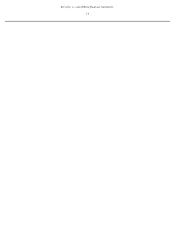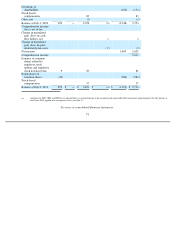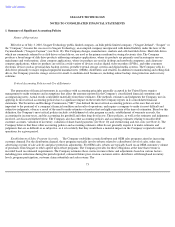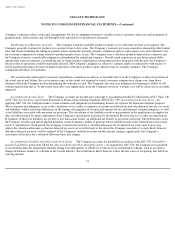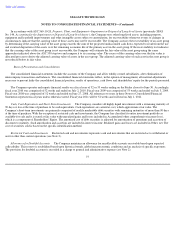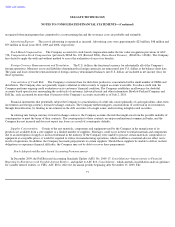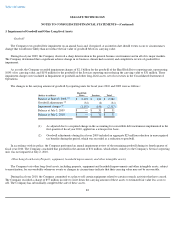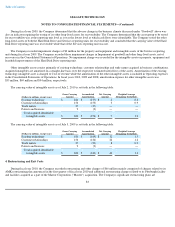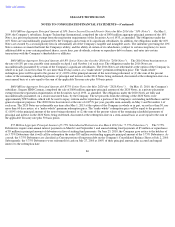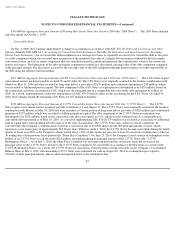Seagate 2009 Annual Report Download - page 83
Download and view the complete annual report
Please find page 83 of the 2009 Seagate annual report below. You can navigate through the pages in the report by either clicking on the pages listed below, or by using the keyword search tool below to find specific information within the annual report.
Table of Contents
SEAGATE TECHNOLOGY
NOTES TO CONSOLIDATED FINANCIAL STATEMENTS—(Continued)
Company is currently evaluating the impact of this update and the pending adoption of ASC 810 on its consolidated financial statements.
In December 2009, the FASB issued ASU No. 2009-16, Transfers and Servicing—Accounting for Transfers of Financial Assets, an update
to ASC 860, which amends de-recognition guidance for transfers of financial assets. ASC 860 is effective for annual periods beginning after
November 15, 2009. The Company is currently evaluating the impact of this update and the pending adoption of ASC 860 on its consolidated
financial statements.
In October 2009, the FASB issued ASU No. 2009-14, Software (ASC Topic 985)—Certain Revenue Arrangements That Include Software
Elements
, a consensus of the FASB Emerging Issues Task Force. This guidance modifies the scope of ASC subtopic 985-605, Software-
Revenue Recognition
to exclude from its requirements (a) non-software components of tangible products and (b) software components of
tangible products that are sold, licensed, or leased with tangible products when the software components and non-software components of the
tangible product function together to deliver the tangible product's essential functionality. This update requires expanded qualitative and
quantitative disclosures and is effective for the Company's first quarter of fiscal year 2011. The Company does not expect the adoption to have a
material impact on its consolidated financial statements.
In October 2009, the FASB issued ASU No. 2009-13, Revenue Recognition (ASC Topic 605)—Multiple-Deliverable Revenue
Arrangements
, a consensus of the FASB Emerging Issues Task Force. This guidance modifies the fair value requirements of ASC subtopic 605-
25, Revenue Recognition-Multiple Element Arrangements by allowing the use of the "best estimate of selling price" in addition to vendor-
specific objective evidence (VSOE) and verifiable objective evidence (VOE) (now referred to as TPE standing for third-party evidence) for
determining the selling price of a deliverable. A vendor is now required to use its best estimate of the selling price when VSOE or TPE of the
selling price cannot be determined. In addition, the residual method of allocating arrangement consideration is no longer permitted. This update
requires expanded qualitative and quantitative disclosures and is effective for the Company's first quarter of fiscal year 2011. The Company does
not expect the adoption to have a material impact on its consolidated financial statements.
In January 2010, the FASB issued ASU No. 2010-06, Fair Value Measurements and Disclosures (ASC Topic 820)—Improving Disclosures
About Fair Value Measurements
. The ASU requires new disclosures about transfers into and out of Levels 1 and 2 and separate disclosures
about purchases, sales, issuances, and settlements relating to Level 3 measurements. It also clarifies existing fair value disclosures about the level
of disaggregation and about inputs and valuation techniques used to measure fair value. The new disclosures and clarifications of existing
disclosures are effective for the Company's third quarter of fiscal year 2010, except for the disclosures about purchases, sales, issuances, and
settlements relating to Level 3 measurements, which are effective for the Company's first quarter of fiscal year 2012. Other than requiring
additional disclosures, the adoption of this new guidance did not and will not have a material impact on the Company's consolidated financial
statements.
78




